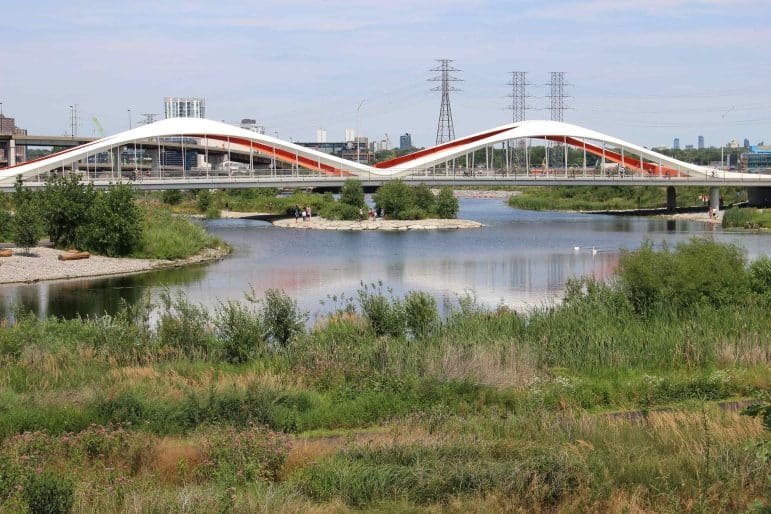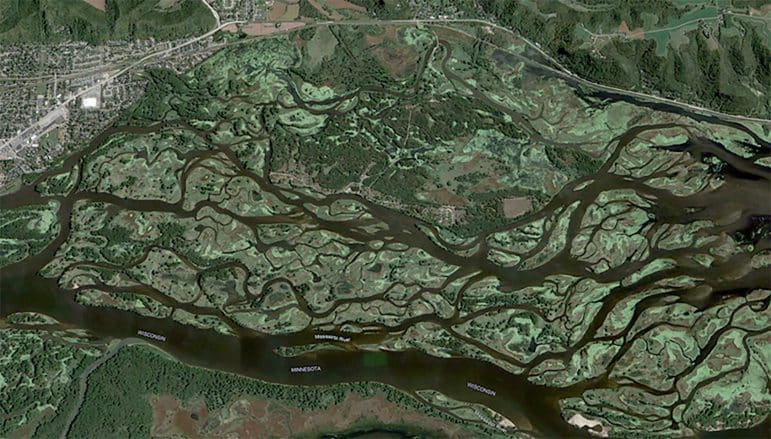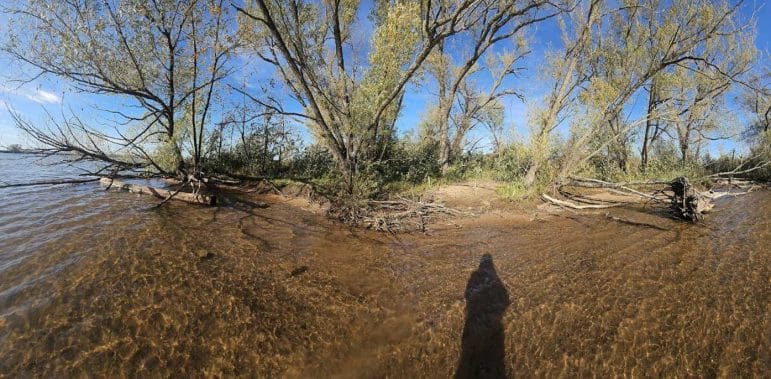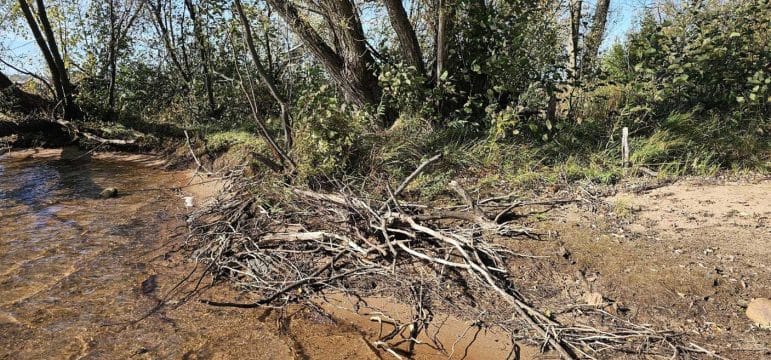
Restoring Function in Urban Ecosystems
What we can do in urban settings is work to restore nature’s functions within our communities to recover the natural ecological processes and services that existed before urbanization.
By Michelle Platz, PhD, Environmental Engineer (Ann Arbor, MI), Craig Taylor, PE, Hydraulics and River Rehabilitation Specialist (Oakdale, MN), and Tim Dekker, PhD, PE, CEO & President (Ann Arbor, MI)
July 28, 2025
Restoring Ecosystem Function
Many ecosystem restoration efforts aim to make progress toward recovery by returning a degraded, damaged, or destroyed system to some resemblance of its pre-disturbance (or reference) state. In urban environments, recovery must look somewhat different. We can’t simply remove the buildings and infrastructure in our cities, towns, and villages and revert developed areas to a pre-disturbance state. What we can do in urban settings is work to restore nature’s functions within our communities to recover the natural ecological processes and services that existed before urbanization.
A functional ecosystem is adaptive, self-regulating, and one where stability and resilience are built in. Over the last 50 years, our world has become more developed, and we’re experiencing more extreme weather than ever before. Cities everywhere are learning that it’s simply too expensive to fight nature, and this shift in attitude creates opportunities: when we work with nature, we have the chance to create urban spaces that can adapt to changing conditions, just like ecosystems do.
In this article, we discuss our approach to restoring ecosystem function within riverine and coastal systems, as well as the key role that functional design plays in restoring our urban spaces.
Flooding – Riverine Systems
We all know rivers move water, but they also transport sediment – sometimes huge amounts. Consequently, most rivers are dynamic and in a constant state of evolution. For example, the issue of stream incision (bed erosion) in response to a river-straightening project is a classic problem caused by a lack of consideration for the stream’s evolutionary response to a perturbation. A straightened stream often degrades (erodes) in predictable ways. Looking forward, as we attempt to restore function to degraded streams, we must also consider the current evolutionary path that each stream is on to ensure that we are working with those processes.
Working with evolutionary processes offers unique opportunities to use small interventions to create relatively large improvements in ecological function. The Lacrosse River Marsh is a great example of a place where we can utilize small interventions that leverage evolutionary processes. Historically, the Lacrosse River near the Lacrosse Marsh was an anastomosing (multi-channel) river with highly connected wetland complexes interspersed throughout.

After a century of encroachment from linear infrastructure, such as roads, trails, waterlines, and railroads, the river is now a single-threaded meandering channel alongside a series of relatively isolated marsh cells. These cells capture and retain floodwater and local stormwater for extended periods, which in turn drowns the remaining emergent wetlands.
It is simply not feasible to remove all the linear infrastructure throughout the marsh. Instead, our hydraulic modeling of the system revealed that isolated breaches through the infrastructure via small bridges and culverts could restore the hydrology of the marsh and, by extension, many of its geomorphic ecological functions. By strategically allowing water through the infrastructure at key locations, we are opening the door for the back-channel morphology to evolve via its own processes. This sets the stage for the functions of a river and wetland complex to reassert themselves. It was a small move and strategic approach on our part that made a big difference.
Coastal Processes
Coastal ecosystems, specifically those found along oceanfront and Great Lakes shorelines, are some of the most dynamic landscapes in the world. These transitional spaces between land and water are some of the most productive environments, providing food and habitat for countless species (ourselves included), and are responsible for performing many of the physical, chemical, and biological processes that our health and well-being rely on. It’s no wonder that people inherently want to be on and around the coasts.
Coastlines come in various forms, from cliffs and bluffs to dunes and beaches, emergent wetlands and salt marshes, and even nearshore reef structures. Each coastal configuration performs its own unique and specialized function, largely influenced by the shape, orientation, and composition of the shoreline.
For example, shallow offshore reef structures, gently sloped beach expanses, and shorelines vegetated with emergent wetland plants all dissipate wave energy from the open water in their own way, protecting coastal communities from the impacts of storms and fluctuating water levels. When natural coastal processes like sediment transport and deposition or wave attenuation are interrupted, however, the coastline’s ability to perform critical protection services is also disrupted. The effects are often felt by our coastal communities like a series of dominoes as they tip over one after another.
In our efforts to satiate our innate human desire to live and be close to the waterfront, coastal development has historically relied on “hard” infrastructure to stabilize the soil on eroding cliffs or to protect coastal settlements and roads from storm surges and wave energy. The challenge with many of these static coastal structures is that they are often designed around a constrained set of conditions with a focus on creating stability. Yet, some structures are placed in some of our most dynamic locations and are anything but stable, as they constantly evolve in response to the changing environment.
This approach to combat nature, rather than working with natural processes, creates coastal resilience challenges and results in non-functional urban coastlines. Inserting abrupt, steep changes where the transition between the land and water had previously developed over millennia to be gradual interrupts the shoreline’s natural wave attenuation function and can often intensify erosive forces in front of, behind, and adjacent to these hard coastal structures. Further, such structures sever the ecological connectivity between land and water by eliminating the soft, gradual transitional spaces that have historically provided wildlife access to both the upland and the open water environments.
When working in coastal environments, we strive to understand and honor natural processes as much as possible, mimicking the shape and substrate composition of natural forms to restore the function of urban coastal areas.
When working in coastal environments, we strive to understand and honor natural processes as much as possible, mimicking the shape and substrate composition of natural forms to restore the function of urban coastal areas. Nature-based solutions such as living shorelines help us address coastal challenges through process-based approaches, working with natural dynamics such as sediment transport and wave energy to benefit our coastal communities and wildlife. This nexus between hard and natural infrastructure focuses on establishing dynamic stability, whereby our coastlines can adapt and change over time yet still maintain a stable function under a variety of environmental conditions. We believe that meaningful integration of coastal ecology within urban waterfront ecosystems recognizes, utilizes, and participates in these shoreline dynamics, ultimately creating more functional and resilient coastal communities.

An example of restoration mimicking nature is underway in Ashland, Wisconsin, a port on Lake Superior, near the head of Chequamegon Bay. The coastal wetlands near the Bay City Creek mouth, where it empties into Chequamegon Bay, do not have the large rock outcroppings that we typically associate with coastal headlands. Instead, the shoreline has mini-headlands formed not by rock, but by dense clusters of tree roots. Over the last decade, high water events, changes in wind conditions, and invasive species (such as emerald ash borer and buckthorn) have contributed to the loss of these woody headlands.

Our coastal restoration approach is to set up the conditions for new woody headlands to establish, grow, and stabilize the shoreline. The design uses intentionally undersized armor stone to create temporary, semi-stable conditions for live cuttings of willow trees to root and establish themselves. The goal is for the stone to provide just enough stability to protect the tree roots over the first growing season or two. Then, as the trees mature, they will displace the stone and their roots will provide a resilient structure to the new woody headlands.
Meaningful Ecological Restoration in Urban Environments
Meaningful ecological restoration in urban settings is about restoring nature’s functions within our communities wherever possible and, to the greatest extent possible, moving away from monofunctional designs and embracing the dynamism and complexities that come with functional natural designs. In our next article, we’ll dig deeper into the role that complexity plays in our approach to urban ecological restoration and how, when we design our urban infrastructure to support nature’s complexity, we help create a self-sustaining and more resilient urban ecology.
If you want to learn more about LimnoTech’s approach to bringing urban ecology into the built environment, reach out to Michelle Platz at mplatz@limno.com. You can also learn more about LimnoTech’s restoration practice area and work by checking out our Urban Ecology & Naturalization and Waterway and Ecosystem Restoration pages.
This article on restoring ecosystem “Function” is the second in a series of articles authored by LimnoTech staff on urban ecology. The first article introduced LimnoTech’s approach to bringing nature into the built environment, which includes the three guiding principles of Function, Complexity, and Connection. In the articles to follow, we’ll describe the two other guiding principles of Complexity and Connection with examples of projects, partnerships, and lessons learned along the way.
Links to the other urban ecology articles in this series are provided below:
Urban Ecology – Bringing Nature to the Built Environment
Follow us on LinkedIn and check the Insights & Perspectives page on our website for more information and updates.
Michelle Platz, PhD, is an Environmental Engineer specializing in aquatic ecosystem restoration planning and design, as well as developing ecosystem recovery monitoring frameworks to evaluate habitat-level impacts of restoration interventions in freshwater and marine environments. Michelle brings expertise in ecological engineering, specializing in the application of nature-based solutions and community-engaged project development to enhance the resilience of Great Lakes coastal cities to climate change-related challenges. Michelle leads the biological sciences, ecosystem services, and fisheries service practice areas at LimnoTech and has experience working in transdisciplinary teams, including academic, non-profit, municipal, and federal groups.
Craig Taylor, PE, is a Hydraulics and River Rehabilitation Specialist with over 15 years of professional experience in restoration design, physical hydraulics, sediment transport, and stormwater modeling. Craig thrives in collaborative, multidisciplinary teams, taking on environmental restoration and stormwater projects. He has conducted extensive research on stormwater management techniques and has served as a technical leader on over two dozen urban river restoration projects. His skills and expertise include physical and numerical modeling, channel morphology, scour assessment, armoring design, ecological flow regimes, storm sewer networks, and riparian restoration. Craig serves as an instructor at the University of Virginia’s Landscape Architecture graduate program, and he holds a Stream Restoration Certificate from the University of Minnesota.
Timothy Dekker, PhD, PE, is the President and CEO of LimnoTech. Tim is an Environmental and Water Resources Engineer with expertise in urban stormwater management and urban waterway remediation and restoration. Tim has led scientific studies and projects throughout North America, describing the dynamics of surface water, sediments, and groundwater systems, assessing and mitigating the effects of urban flooding, and developing urban stormwater and CSO control strategies. Tim has contributed to successful national design competitions and projects focusing on restoring and revitalizing urban waterfronts. He brings an integrative approach to problem-solving that blends science and engineering with highly collaborative, multidisciplinary design and planning. Tim has served as a lecturer and adjunct professor of environmental engineering at the University of Michigan and is a regular lecturer and studio critic at the Harvard University Graduate School of Design.




